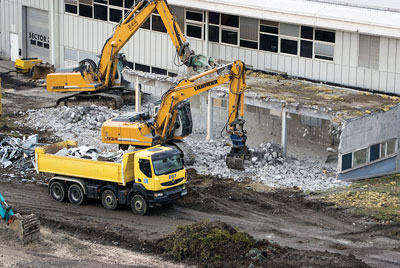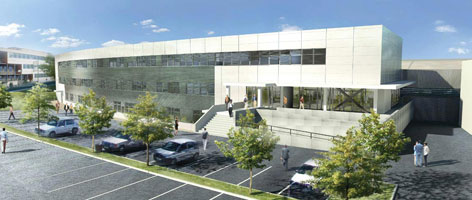- Home
- News
- General News
- The ESRF shines...
The ESRF shines on
21-03-2012
The ESRF is undergoing a transformation that will ensure it remains the world’s leading provider of hard X-ray light.
Share
With a ceremonial strike of a pickaxe on 29 November, ESRF director-general Francesco Sette marked the start of civil construction works for the ESRF upgrade. Meanwhile, a fleet of heavy plant began the task of excavating some 50 000 tonnes of earth to prepare the foundations for the associated upgrade buildings. By the time the lorries have departed in spring 2013, the ESRF will boast two new experimental halls flanking the main building, a new satellite building and some 3400 m2 of fresh office space.
Eight new beamline projects, comprising 11 beamlines and 15 independently operable stations, will then be unleashed. Alongside refurbishments and improvements to existing ESRF beamlines, plus a brand-new Science Building to be built next year, the upgrade will ensure that the ESRF meets the scientific demands of users for the rest of the decade. The first public beamline upgrade is already complete: ID24, which is devoted to time-resolved and extreme-conditions X-ray absorption spectroscopy, was inaugurated on 28 November.
The idea for a major upgrade to the ESRF dates back to 2003, when management updated to its long-term scientific plan to the ESRF Council. “The ESRF was operating extremely well at the time, so one option was to continue as we were,” recalls former ESRF director-general Bill Stirling, who is now scientific coordinator for Grenoble’s GIANT partnership. “But from looking at other facilities and labs in the world, we realised that we needed a major upgrade to maintain the ESRF’s position as one of the best – if not the best – X-ray sources in the world. The upgrade represents five years of my life and I am extremely impressed by what the ESRF’s staff and user community have achieved.”
After several years of difficult financial discussions and extensive scientific and technical considerations, which culminated in the publication of the two-volume “Purple Book”, in 2008 the ESRF received funding for the first phase of the upgrade pertaining to the period 2009–2015. The total cost of the project was fixed at slightly more than €170 m, 75 m of which was to come from the ESRF’s continual reinvestment budget.
 |
Out with the old: wreckers make way for the extended ESRF experimental hall and new laboratory and office building (Credit: C. Argoud/ESRF). |
A 6% reduction in financial contributions to the ESRF, which came to light in 2010, has delayed construction by six months and forced the cancellation of one new experimental hall extension (the “Vercors” building) and one satellite building at ID20. The timing of the upgrade was nevertheless fortunate, insists former upgrade preparation leader Ed Mitchell. “The council gave us the ‘green light’ in the autumn of 2008, just before the economic crisis hit,” he says. “Had we been just a few months later, it’s less sure that the upgrade would have gone ahead.”
Synchrotron science has changed dramatically since the ESRF started up in 1992, as anyone who is fortunate enough to own a copy of the ESRF “Red Book” – which set out the founding goals of the facility in 1987 – will attest to. For instance, the life sciences were expected to take up only a small fraction of proposals without the exploitation of undulator beamlines, yet today macromolecular crystallography (MX) is the largest single user group – with an extensive new MX suite called MASSIF being a major component of the upgrade. Meanwhile, subjects such as palaeontology and cultural heritage have blossomed despite not being on the radar when the ESRF was built. An important advance at the ESRF has been the exploitation of the coherence properties of its X-ray beams, allowing higher-resolution imaging and dynamical studies.
“That’s how it should be – it’s progress,” says research director Harald Reichert. “In planning for Phase II of the upgrade we’re not only sticking just to the ‘Purple Book’ anymore because that was five years ago and science has evolved since then.”
Smaller, brighter beams are the theme of the ESRF upgrade, with beams as small as 10 nm allowing users to address the behaviour of matter in volumes comprising just a few thousand atoms. In addition to major improvements to the accelerator and source, most of which are already in place, the upgrade will allow longer beamlines to be operated with vastly improved optics, detectors and data-analysis tools. A new satellite building located 185 m from the storage ring will house a dedicated nano-imaging and nano-analysis facility (“NINA”), but many other beamlines will benefit from more tightly focused, nano-sized beams.
“NINA is a star of the upgrade in terms of industry users,” says Mitchell. “It will have killer applications in focusing our X-ray beams down to minute spot sizes, as does the new ID31 project, which will be at very high energies, plus there’s the MASSIF facility, which will open the door to phenomenal amounts of sample throughput for protein crystallography.”
 |
|
Artists impression of the new laboratory and office building. |
Serving society
Nanoscience and technology is one of five core areas of applied and fundamental research that the upgrade is designed to address. The others are: pump-probe experiments and time-resolved diffraction (with time resolutions sufficient to “film” the movement of single atoms or even electrons); science at extreme conditions (offering the capacity to study minute quantities of matter under very high pressures, temperatures and magnetic fields); structural and functional biology and soft matter (elucidating, for instance, the basic mechanism of molecular machines and cellular reproduction), and X-ray imaging (with applications ranging from medicine to archaeology).
Such capabilities are intended to support the scientific communities of the ESRF’s member and scientific associate countries to better address health, energy, environment and climate change, new materials and nanotechnology. “At the time of the ‘Red Book’, the ESRF was considered a pure fundamental science machine, but if you look at the users’ needs today you will see that applied sciences and innovation constitute a large part of the user community and are very well served by the five science areas that we are targeting,” says Reichert.
Every ESRF beamline will undergo at least some form of upgrade, and those with only light improvements will be candidates for Phase II of the upgrade beginning in 2015. The national “CRG” beamlines will not receive additional ESRF funding, but they stand to benefit from improvements to the source, sample environments and larger experimental halls. A major upgrade to the German beamline ROBL (BM20) was inaugurated on 10 November.
“Being the first third-generation synchrotron to be built, the ESRF has always served as a model for other synchrotrons, and this is true of its upgrade programme too,” says Brian Stephenson, director general of the Advanced Photon Source in Argonne, US, which has recently completed a conceptual design report for a major upgrade of its own. “We always appreciate the pioneering efforts of the ESRF.”
Upgrading the source
The ESRF upgrade pushes the performance of the storage ring, booster and linac beyond even the most optimistic expectations at the time of their design. Crucial developments during Phase I of the upgrade include:
- Enhanced beam-position diagnostics providing higher beam stability and enabling reduced vertical emittance.
- Increasing the useful length of the straight sections to 6 m (one 7 m section), creating space for more undulator beamlines via “canting”.
- A new and more modular RF power source based on semiconductor technology to replace ageing high-power klystrons.
- Improved RF cavities with “higher-order mode damping” to replace the existing cavities, enabling the beam current to be increased to 300 mA.
- Improved control systems across the source and beamlines.
ESRF upgrade timeline: the future is now…
- MAR 2012
- Works start on Science Building
- MAY 2012
- End of long shutdown; laying of concrete for experimental-hall extension; ID24-S starts user operation
- JUN 2012
- BM29 starts user operation
- SEP 2012
- ID16 satellite building available; ID24-L starts user operation
- JAN 2013
- Restaurant and other common-building works begin
- MAR 2013
- Chartreuse extension and new laboratory & office building available; ID20 starts user operation
- MAY 2013
- Belledonne extension available; ID30A starts user operation
- MID-2013
- Refurbishments of ID10 (Feb) and ID19 (May) complete
- SEP 2013
- Commissioning of Science Building
- DEC 2013
- Refurbished common building, including restaurant, and new site entrance available
- FEB 2014
- New ID16 starts user operation; ID31 refurbishment complete
- APR 2014
- New ID02 starts user operation
- MAY 2014
- New ID30B starts user operation
- JUN 2014
- New ID32 starts user operation
- DEC 2014
- New ID01 starts user operation
- EARLY 2015
- New ID31 starts user operation; Phase II of upgrade begins
ESRF upgrade timeline: all that is history
- DEC 2011
- Start of long shutdown for upgrade building civil-engineering works
- NOV 2011
- Inauguration of ID24/BM23 and BM20 beamlines
- AUG 2011
- First 6 m straight machine section equipped with 4 undulator carriages
- MAY 2011
- Inauguration of new data centre
- APR 2011
- First tower of the new solid-state RF amplifier installed
- MAR 2011
- Upgraded BM23 starts user operation
- APR 2010
- New beam-position monitoring system installed
- MID-2009
- Conceptual design reports for all public ESRF beamlines
- 2008
- Funding granted for Phase I of the Upgrade
- 2007
- Publication of the ESRF “Purple Book”
- 2006
- Upgrade science case presented to ESRF council
- 2003
- Formal Upgrade discussions begin
- 1998
- 40 beamlines in operation
- 1992
- First electron beam in storage ring
- 1988
- Signature between governments of 12 member states
- 1987
- Publication of the ESRF “Red Book”
Matthew Chalmers
This article appeared in ESRFnews, March 2012.
To register for a free subscription and to rapidly receive the current issue, please go to: ESRFNews Digital Edition Subscription
Top image: The ESRF shines on (Image credit: Mihail Ulianikov/istockphoto)



